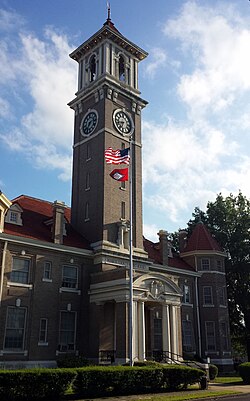Clarendon, Arkansas | |
|---|---|
 Monroe County Courthouse in downtown Clarendon | |
 Location in Monroe County, Arkansas | |
| Coordinates: 34°41′35″N91°18′23″W / 34.69306°N 91.30639°W | |
| Country | United States |
| State | Arkansas |
| County | Monroe |
| Area | |
• Total | 1.93 sq mi (5.00 km2) |
| • Land | 1.75 sq mi (4.53 km2) |
| • Water | 0.18 sq mi (0.46 km2) |
| Elevation | 174 ft (53 m) |
| Population | |
• Total | 1,526 |
• Estimate (2024) | 1,439 |
| • Density | 872.50/sq mi (336.84/km2) |
| Time zone | UTC-6 (Central (CST)) |
| • Summer (DST) | UTC-5 (CDT) |
| ZIP code | 72029 |
| Area code | 870 |
| FIPS code | 05-13990 |
| GNIS feature ID | 2404054 [2] |
| Website | www |
Clarendon is a city in and the county seat of Monroe County, Arkansas, United States. [4] Located in the Arkansas Delta, the city's position on the White River at the mouth of the Cache River has defined the community since first incorporating in 1859. Although the river has brought devastation and disaster to the city occasionally throughout history, it has also provided economic opportunities, transportation, recreation and tourism to the city.
Contents
- History
- Settlement through antebellum period
- Civil War and Reconstruction
- Gilded age through early 20th century
- World War II onwards
- Geography
- Climate
- Demographics
- 2020 census
- 2000 census
- Economy
- Education
- Infrastructure
- Healthcare
- Transportation
- Utilities
- References
- External links
Once home to a variety of industries, today Clarendon's economy is largely based on agriculture. Similar to many Delta communities, the city's population has been dwindling since mechanization on the farm reduced the number of agricultural-related jobs in the area. At the 2020 census, the population was 1,526, [3] the lowest value recorded since 1890. [5]



